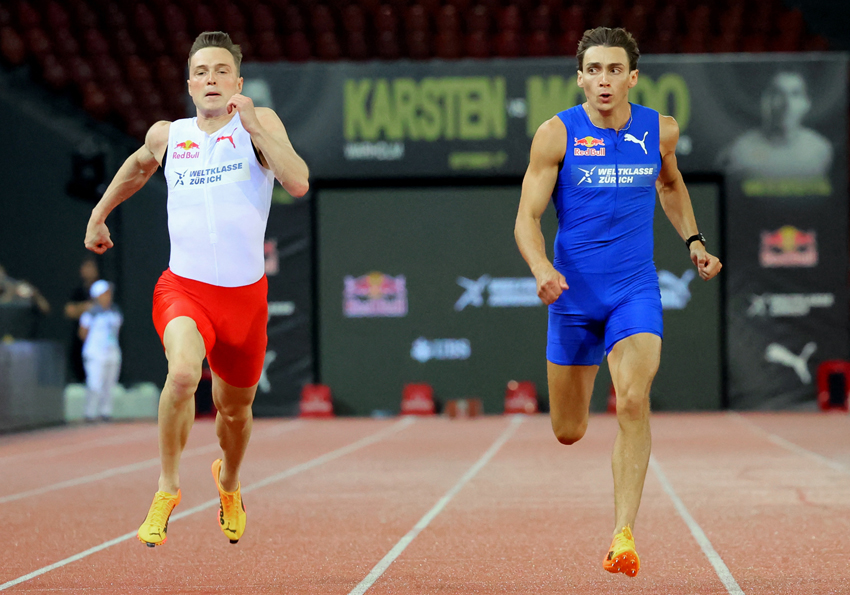Interval program training
To make your workouts more realistic, you should aim to trim down the recoveries
In training, sometimes the most important thing is not what you actually do - if you're a runner, your 1200-metre intervals at 95-per cent effort, your hill surges at 5-K intensity, your controlled tempo runs at just under 10-K speed, or your marathon-paced 10-mile efforts - but what you don't do. For example, skipping a few workouts may spare you from serious injury when a minor sore spot in your body is on the verge of becoming a major problem. Cutting back on your workouts for a week or so after a bout of very strenuous training can reduce your risk of staleness or overtraining. And not recovering properly between work intervals can increase the realism and specificity of your training and give your overall fitness a tremendous boost.Not recovering? Of course - remember that the purpose of a recovery interval is to lower heart rate and reduce leg-muscle fatigue enough to permit another work interval to be conducted at a desired pace. The basic idea is that, by including periodic rests, more total quality work can be carried out in a particular training session, compared with a workout in which a high intensity level is sustained without relief. With good recoveries, for example, you might be able to pile up eight half-mile repeats in a workout, instead of just six, and thus get in 33-per cent more work at a very tough running velocity.
And that's beautiful, except that recovery intervals also teach you to perform in a start-stop manner. Athletes who rely heavily on interval training (with good recovery periods) may have trouble sustaining quality paces for long periods in competitions, because they have in effect learned to lumber along slowly every few minutes or so. True, tempo training (with continuous, hard efforts which last for 25 minutes or more) is a way around that problem, but the velocity of tempo sessions is so reduced that the gains in efficiency at race pace and in VO2max are not as great, compared with interval sessions. While tempo workouts are a key aspect of your training, you also need to focus on trimming the recoveries within your interval sessions - to make your interval workouts more realistic.
Graduating from 1:1
In the pages of PP, we often recommend 1:1 ratios for your interval training - that is, one minute of recovery for each minute of your work intervals. With 1:1, if you run half-mile repeats in three minutes each, for example, the recovery between these work intervals is also three minutes. That's great for the early stages of your training, but to get around the key problem, which is that recovery intervals can slacken the average intensity of a workout, teach your leg muscles to depend on frequent rests, and thwart the development of speed stamina, we need to use the principle of progression with recovery intervals, just as we would with the work bouts.
For example, if you're a runner you wouldn't dream of continually using the same 5-K pace for your VO2max intervals. As your 5-K performances improve, your interval pace also steps up. Similarly, you shouldn't dream of taking the same-old long recoveries between work intervals as your fitness begins to climb. Your work:rest ratio can progress from 1:1 to 1.5:1 to 2:1, and so on. As you'll see in a moment, you can even complete some workouts in which there is no recovery at all - the expected recovery is simply missing at key points in your session. By shortening your recoveries, you'll be heightening the average intensity of your workout, learning to exercise intensely when you are fatigued (developing speed stamina), and making your workouts much more realistic. You'll also become a much more formidable racer.
Getting practical
So how does this work in practical terms? Well, let's say you're a runner who currently completes 5Ks in 20 minutes (1:36 per 400) and10Ks in approximately 42 minutes (about 1:40 to 1:41 per 400), just to use some nice even numbers (it doesn't matter what your actual times are or that you may be a cyclist, swimmer, rower, or other type of athlete; you can easily adapt your own paces to the discussion that follows and create very effective workouts). If you're a PP disciple and a runner, you would be doing your VO2max-building work intervals at 5-K pace, and one of your key workouts would 4 x 1200 metres in 4:48 each (1:36 per 400), with recoveries lasting - you guessed it - about 4:48. If you're a swimmer or cyclist, you would simply be hustling through five-minute intervals at an intensity you could only sustain for 15 minutes or so (your recoveries would also be five minutes).
It's a nice workout. As you complete your 1200s, you are working at your current 5-K pace, which makes you more economical at that velocity, heightens your VO2max, and also makes 5-K race speed more mentally acceptable (less damaging to your fragile mind, which for purposes of self-preservation often cries out for easier ambling and rest). The total distance of the quality exertion - 4800 metres (or about 20 minutes if you're not a runner) - also resembles a 5-K race effort. Overall, it's very much like running a 5-K race, except for those long, 4:48 jog slumbers (the recovery intervals).
So, once you can handle the workout pretty well, the recoveries have gotta go. The first step, of course, is to trim them to four minutes flat. After a couple of sessions like that, you can upgrade to a three-minute-recovery workout, and then into the fiery physiological cauldron created when recovery lasts just two minutes. Once the two-minute recoveries are utilised successfully, it is almost assured that you will charge through a real 5K in a new PB.
What happens then? Well, let's say that you've chopped your 5-K time from 20 minutes to 19:10 (1:32 per 400). Sticking with the 1200s, a cool workout would be 4 x 1200 in 4:36 (1:32 per 400 pace), but how long should your recoveries be? Well, there is absolutely no need to go back up to four minutes and thirty-six seconds of rest. You've proven that you're fitter; in fact, you've demonstrated that you can handle a whole 5000 metres at 1:32 pace without stopping. Since there's no need to rest for over four minutes after every 1200, you can start with about 3:24. The nice thing about that would be that you could start a new work interval every eight minutes (4:36 plus 3:24) - on the dot. Once that's manageable, you could descend to 2:54, 2:24, or just 2:00 of recovery. Keep trimming (even down to only 30 to 60 seconds of recovery) until your 5-K PB improves again, and then start the process anew.
Cool points
Shortening your recoveries is a great way to be a progressive trainer - to make your training gradually tougher over time as your fitness ability permits it. If you reach a point where you simply can't manage a workout with less than three-minute recoveries, don't worry about it: you will develop that ability in time. Remember, though, that you should never sacrifice good running form on the altar of abbreviated recoveries. If your abridged recoveries are making you look like a wrecked ship as you careen around the track, broaden the recoveries again until you can use good, relaxed form during your work intervals.
If you're having trouble with the reduced recoveries, another trick is to break your workout down into sets of intervals, rather than straight intervals. For example, if 4 x 1200 with very brief rest is not manageable, you could run a set of 2 x 1200, with only a one-minute rest between the two intervals. Following a four-minute rest, you could complete the second set of 2 x 1200, again with only a 60-second break between intervals. The strategy then would be to begin paring down the break period between sets.
What about our original promise - that we would show you some interval-type workouts with totally missing recoveries? That sounds like an oxymoron, but here's how it would work: Let's say that you're still that original runner who cruises through 5Ks in 20 minutes and 10Ks in about 42 minutes. Your primary goal is to improve your 10-K time; in fact, you would like to break the 40-minute barrier in this key race.
As recommended in PP, you're already doing some longer intervals at 10-K pace. In fact, let's say you're running three or four 2000-metre intervals in 8:20 each, just slightly faster than your current 10-K pace, with five-minute recoveries (since the pace is slower than 5-K velocity, you've already done a little hacking with your recovery time). Now, you could begin slimming that five-minute recovery down even further, which is a reasonable thing to do. But another excellent strategy is to work on that fairly long, 2000-metre interval itself. Instead of merely pacing around the track five times per interval at 1:40 per 400 (the pace which produces about a 42-minute 10K), you could run the first 800 metres at your 5-K pace (in this case, in 1:36 per 400). After this 800, your body will be ready for recovery, but you should instead ramble through 1200 metres in five minutes flat (1:40 per 400, which is your 10-K pace). Impossible? Not at all! You're probably already used to completing one-mile repeats at 5-K pace, so you should be able to handle 2000-metre intervals, with 40 per cent at 5-K speed and 60-per cent at 10-K speed. In this case, you'll complete each 2000 in 8:12 rather than 8:20, putting you on target for a 41-minute 10K and also teaching you to run at 10-K pace even when you are pretty tired (as you must do during the final 1200 of each 2000-metre interval). If you want to go for broke, you can run the first 1200 of the 2000 at 5-K speed and the last 800 at 10-K knottage, completing the interval in 8:08 and setting yourself up for a 40:40 10K.
Or in a tempo session
An even better time to skirt an obvious need for recovery would be during a tempo session. Let's say you're still that 42-minute 10-K runner, and you've planned a three-mile, continuous tempo run in 21 minutes flat (about 13 to 14 seconds per mile slower than your 42-minute 10-K pace). Well, let's liven that one up a bit. Do the session on the track, and instead of just spinning off one 1:45 quarter after another, until 12 quarters and 21 minutes have elapsed, run the third, seventh, and 11th quarter-mile in 1:36 (your 5-K pace) or 1:40 (your 10-K pace). After each of these, your body will crave recovery, but you'll just keep on going. And by doing so you'll develop the ability to handle tough increases in intensity (as when you attempt to 'lose' another competitor or surge up a hill) during your race efforts.
The importance of abbreviated recovery is so great that some successful coaches have been willing to sacrifice actual pace in the work interval in order to maintain very slim recoveries. For example, when Frank Horwill was coaching Tim Hutchings, the latter could not maintain 5-K race pace during his one-mile repeats when Horwill enforced his one-minute recovery rule (recoveries between mile repeats could be no longer than one minute). Hutchings called out for longer recoveries, but Horwill was unrelenting - instead telling Hutching to merely run a little bit slower during the work intervals.
And what happened? Hutchings stuck with the one-minute rests, gradually increased his speed during the one-mile work intervals, and went on to win two silver medals at the World Cross Country Championships. The bottom line? Paring down your recovery intervals is not a training trick. It is a proven way to heighten the average intensity of your workouts, improve your speed stamina, enhance your mental toughness, and move you relentlessly toward some great new PBs!
Owen Anderson
You need to be logged in to continue reading.
Please register for limited access or take a 30-day risk-free trial of Sports Performance Bulletin to experience the full benefits of a subscription. TAKE A RISK-FREE TRIAL
TAKE A RISK-FREE TRIAL
Newsletter Sign Up
Testimonials
Dr. Alexandra Fandetti-Robin, Back & Body Chiropractic
Elspeth Cowell MSCh DpodM SRCh HCPC reg
William Hunter, Nuffield Health
Newsletter Sign Up
Coaches Testimonials
Dr. Alexandra Fandetti-Robin, Back & Body Chiropractic
Elspeth Cowell MSCh DpodM SRCh HCPC reg
William Hunter, Nuffield Health
Keep up with latest sports science research and apply it to maximize performance
Today you have the chance to join a group of athletes, and sports coaches/trainers who all have something special in common...
They use the latest research to improve performance for themselves and their clients - both athletes and sports teams - with help from global specialists in the fields of sports science, sports medicine and sports psychology.
They do this by reading Sports Performance Bulletin, an easy-to-digest but serious-minded journal dedicated to high performance sports. SPB offers a wealth of information and insight into the latest research, in an easily-accessible and understood format, along with a wealth of practical recommendations.
*includes 3 coaching manuals
Get Inspired
All the latest techniques and approaches
Sports Performance Bulletin helps dedicated endurance athletes improve their performance. Sense-checking the latest sports science research, and sourcing evidence and case studies to support findings, Sports Performance Bulletin turns proven insights into easily digestible practical advice. Supporting athletes, coaches and professionals who wish to ensure their guidance and programmes are kept right up to date and based on credible science.









